The logistics companies of the world are always looking for a quicker, more efficient way to move cargo around the planet. Armadas of cargo ships, trains, freighter aircraft, semi-trucks, delivery trucks, and cargo vans work in a delicate dance to keep the world of trade and commerce moving. But what if there were an even better option? One company thinks the future of cargo movement is not any of the vehicles that are currently out there, but a giant airship. The Aeros Aeroscraft is a humongous airship measuring at least 555 feet in length with a cargo hold roughly twice the size of that of a Boeing 747-800. Its mission? Work as a gigantic flying warehouse that floats over Los Angeles. Yes, this thing is serious.
As far as inventor Igor Pasternak is concerned, the world of transportation is due for a change. In his eyes, planes pollute the planet and require long runways, semi-trucks clog up the roads, ocean-going vessels are slow, and shipping in itself could be much faster. All forms of transportation, Pasternak says on his website, are confined by something, be it roads, ports, terminals, traffic, rails, or airports.
To Igor Pasternak, the solution to these problems is a vehicle that doesn’t need a runway, isn’t tethered to a rail, doesn’t have to follow a road, and doesn’t require complex infrastructure. His idea calls for a giant airship as the solution to modern logistics. These airships, which Pasternak is calling Aeroscraft, are supposed to be used to deliver humanitarian relief, wind turbines, and, oh yeah, Pasternak sees one that could be used to hover over Los Angeles to function as a floating warehouse. Pasternak says he plans on testing this concept later this year.
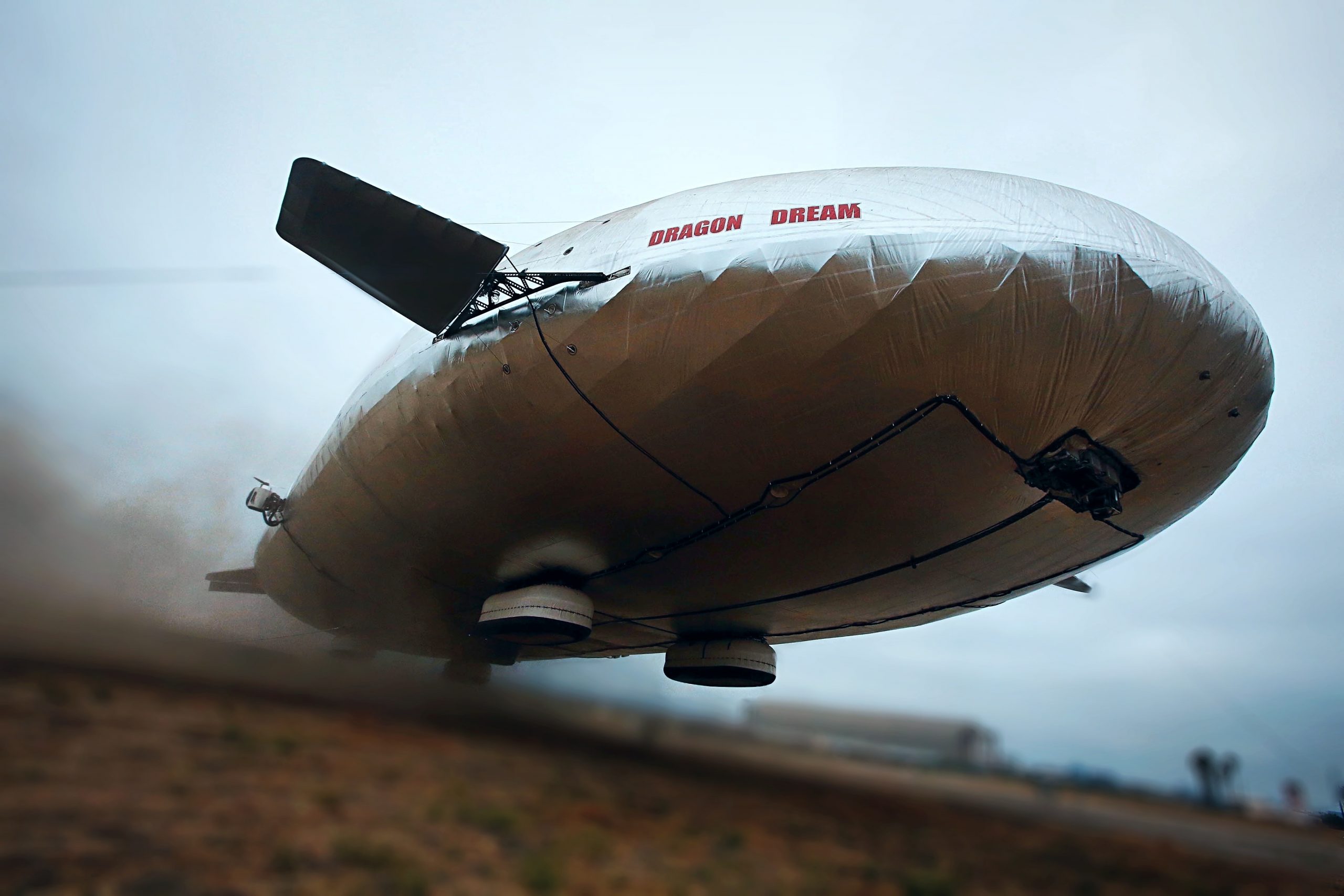
Three Decades Of Airships
Normally, crazy ideas like these are the work of startup companies founded by ambitious dreamers. Los Angeles-based Worldwide Aeros Corporation has actually been around for 30 years and produces airships right now. But, Aeros founder Igor Pasternak is trying to cook up something much bigger than any mere airship.
Pasternak provides this story on Aeros’ website:
In 1987, in the city of Lviv, Ukraine, a team of engineers began researching and developing the concept of a heavy-lift airship. Aeros emerged as the first private aerospace and engineering company permitted under Gorbachev’s Perestroika reforms. It designed and produced aerostat systems for advertising and industrial applications.
In 1995, Aeros designed and manufactured its first airship – the Aeros 50 – in California, and began the sales of airship models Aeros 50 and Aeros 40A for advertising and broadcasting applications.
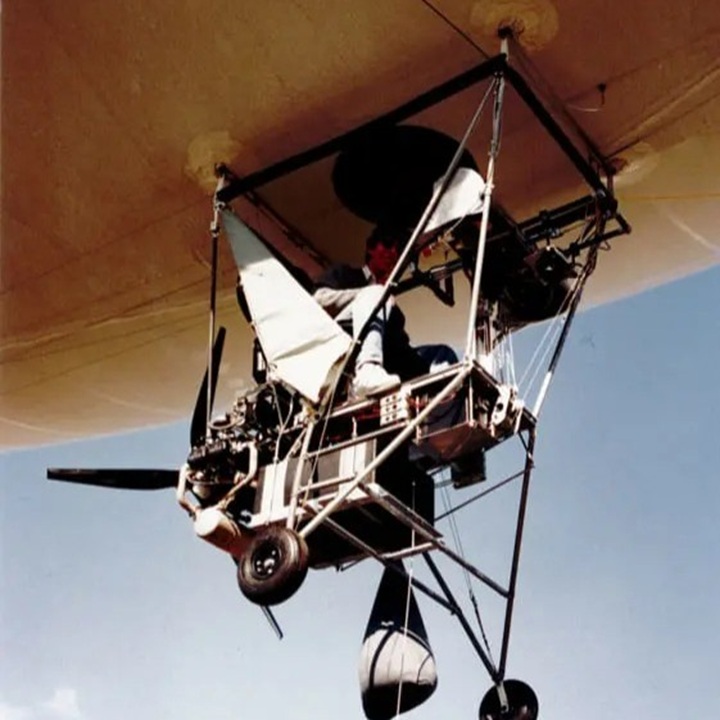
One of the biggest milestones noted by Aeros was the launch of its 40B ‘Sky Dragon’ airship, which was certified by the Federal Aviation Administration in 2000. The 40B also received certification in Europe, and Aeros says it sold the airships all over the world. The company says that the 40B ‘Sky Dragon’ is important because it was the first airship with a fly-by-wire system and an automated pressure management system.
Along with airships, Aeros has produced tethered balloons, the latter of which was found to be appealing to the United States military. Aeros provided 25 tethered balloons and airships to the military for surveillance use during the Afghanistan and Iraq campaigns in the 2000s.
The current airship sold by Aeros is the 40E ‘Sky Dragon’, which entered production in 2014. The Sky Dragon is a non-rigid design with an envelope containing 113,000 cubic feet of volume and a gondola with seating for a pilot plus six passengers. Power comes from a pair of Lycoming AEIO-320-D 5.2-liter air-cooled flat fours good for 160 HP each. Like Goodyear’s blimps, the Aeros Sky Dragon has thrust vectoring for improved maneuverability.
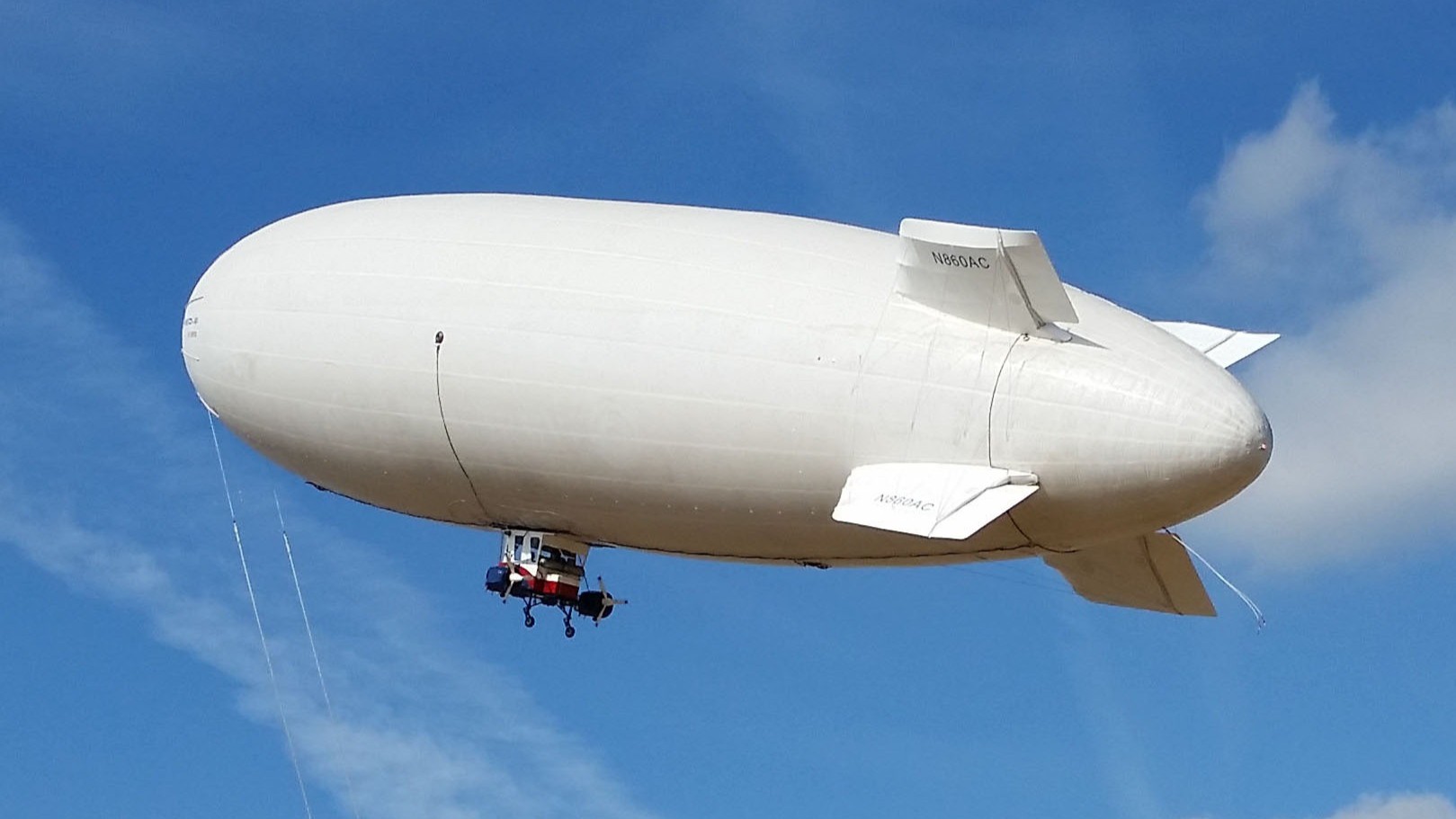
What’s interesting is that the Sky Dragon is not advertised as being for commercial or marketing purposes, which is how Goodyear uses its blimps. Instead, the Sky Dragon is pitched as a “game-changing” and “liberating” airship for maritime patrol, port security, border security, surveillance, and intelligence.
According to The New Yorker, this marketing was intentional. Aeros originally pitched its blimps for advertising use, and then the September 11, 2001 attacks happened. The aftermath of the attacks pushed Pasternak to use his blimps for surveillance rather than advertising. Reportedly, Aeros has built at least nine of these blimps since 2014, so they are real and are being flown around.
The main project of Aeros is far more ambitious.
Heavy Lift Airships

Early in the life of Aeros, Igor Pasternak embarked on a project to more or less reinvent the airship.
A typical airship is loaded up with so much helium that it weighs less than air. One primary reason why these airships don’t just float away has a lot to do with ballast. As I explained in my Goodyear Blimp story, airship operators will weigh their craft down with heavy blocks of material or water. The weight of fuel and passengers also counts as ballast. Operators can add ballast or release lifting gases to reduce buoyancy, and drop ballast to increase buoyancy. Airships are then operated at slightly heavier than air.
Pasternak’s patented idea eliminates the concept of ballast entirely. He calls it the variable buoyancy airship, or more specifically, the Aeroscraft. Here’s how it works, from Aeros:
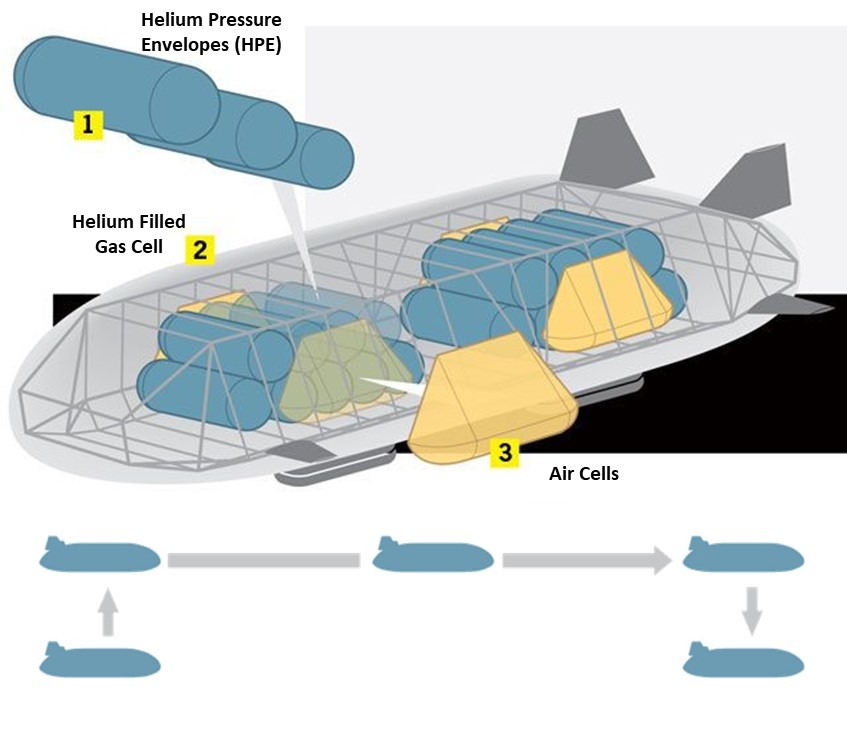
The Control-Of-Static-Heaviness (COSH) system compresses non-flammable helium into the helium pressure envelopes to allow the vehicle to manage buoyant lift similar to the submarine’s ballast management underwater. COSH allows the Aeroscraft to act as a “flying submarine.”
– The biggest obstacle that airships face when tackling the cargo function is their inability to control buoyancy. The requirement for ballast exchange, ground infrastructure, and need for runways significantly limited the usefulness of traditional airships for cargo applications.
– The COSH technology eliminates these requirements and the Aeroscraft is the only airship with hover capabilities making it possible to offload at unimproved landing sites with minimal infrastructure.
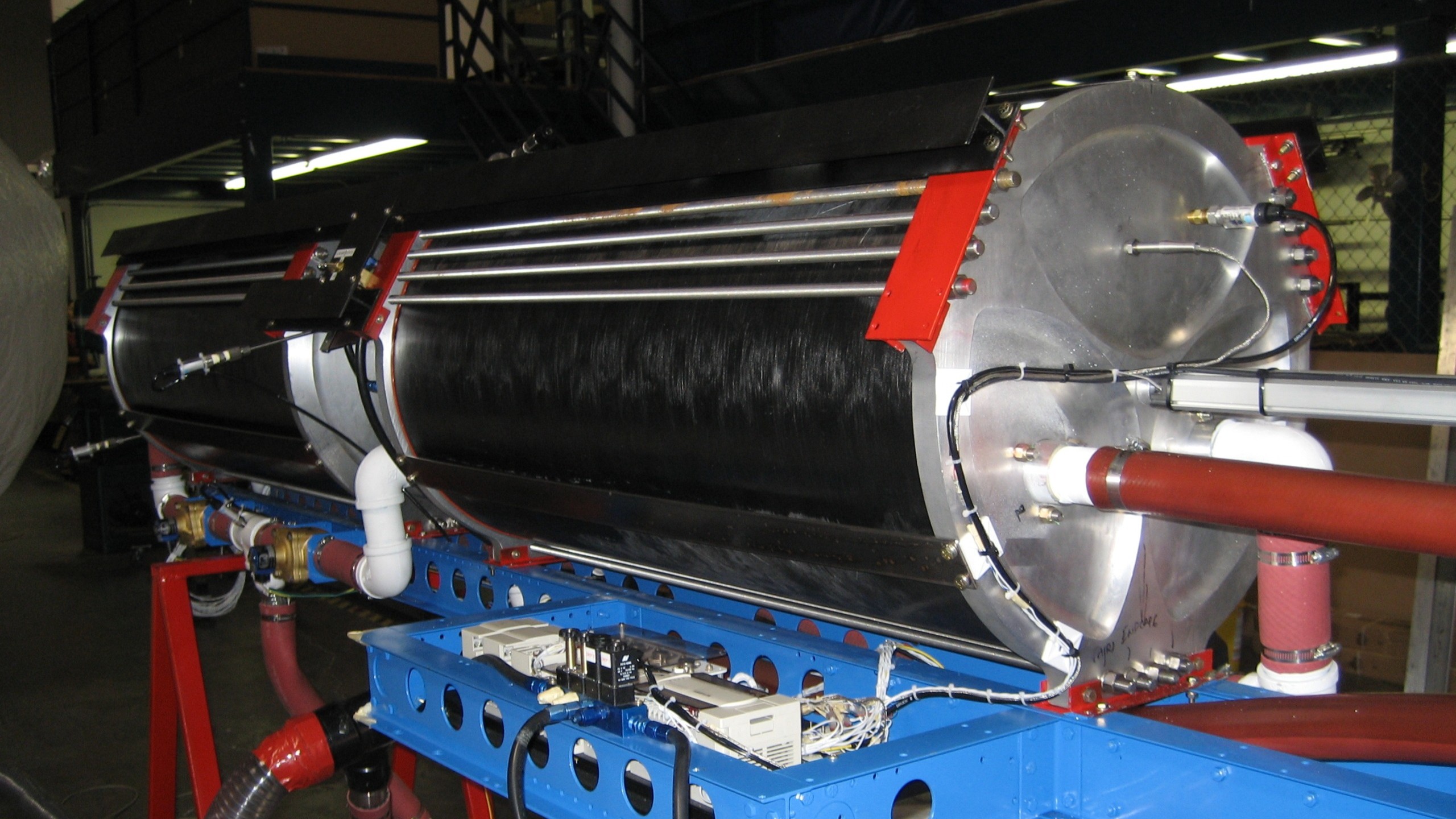
Aeros doesn’t exactly make this clear, but by compressing helium into pressure vessels, the Aeros COSH system increases the density of the gas, therefore making it weigh heavier than air. This has the same effect of adding ballast, but without actually adding ballast.
This technology is wrapped into a rigid airship frame, which means that the shape of the airship is held by an internal superstructure rather than the envelope. From Aeros:
The Aeroscraft has a rigid design and is not dependent on gas pressure made from advanced composite materials, a carbon-fiber geodesic space frame. reduction of the weight without the loss of strength; reduced manufacturing and operation cost, high damage tolerance, and drag reduction.
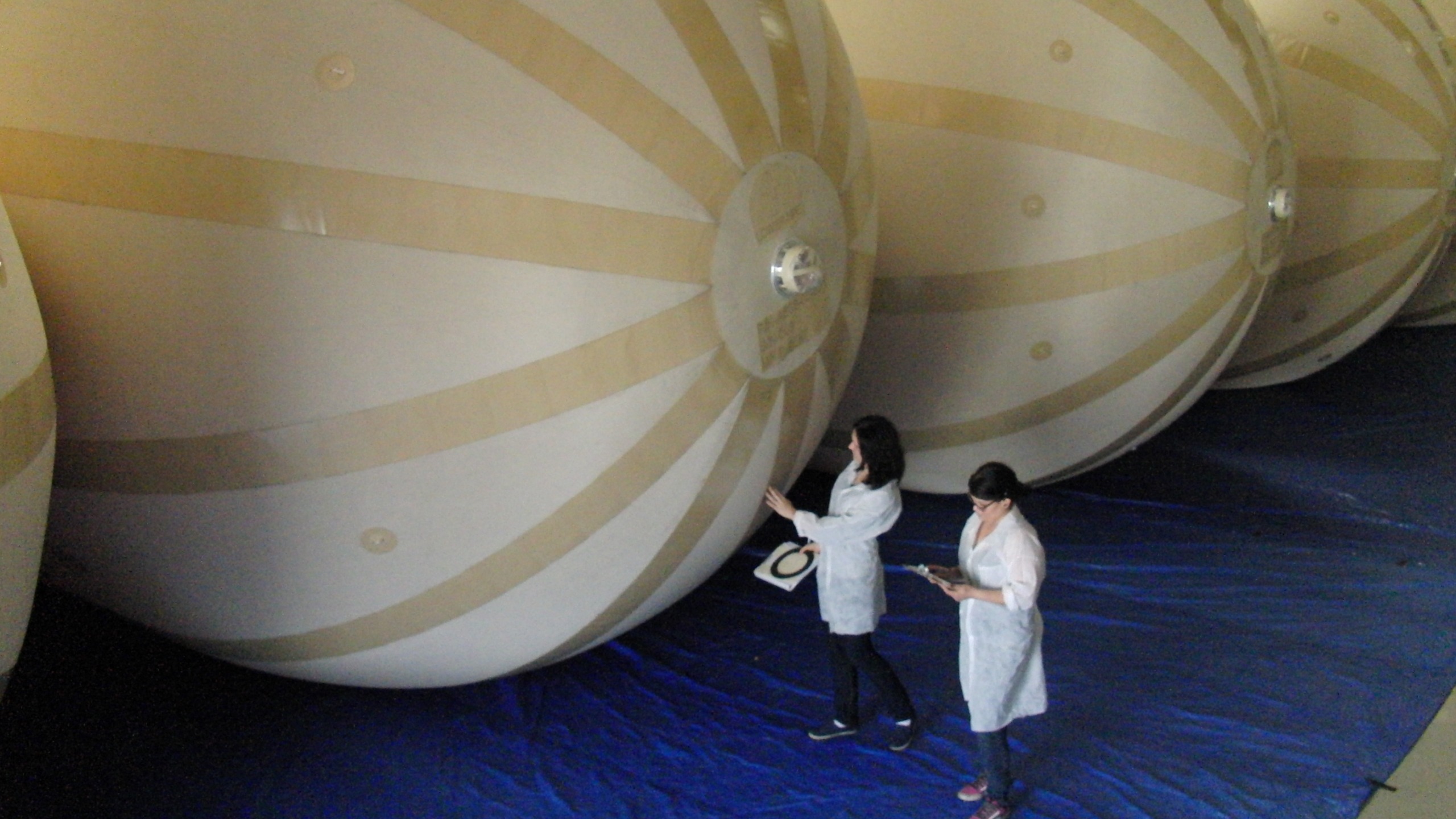
In 2005, Aeros and Lockheed Martin were contracted by the Defense Advanced Research Projects Agency (DARPA) for Project Walrus, which sought to develop a wild heavy-lift hybrid airship capable of traveling 12,000 nautical miles while carrying up to 1,000 tons of cargo. Aeros was granted a $3,267,000 contract under Phase 1 of the project, and in 2006, demonstrated that its COSH concept actually worked in a ground-based test. The project would lose most of its funding that year, but the military was still interested in what Aeros was working on. In 2008, Aeros attached a prototype COSH system to a Sky Dragon blimp and successfully demonstrated COSH in flight.
Before I continue, concept imagery for Project Walrus is just as silly as you’d expect.

Part of the reason why airships fell out of favor with the military in the mid-20th century was that they were so huge and so slow compared to jet aircraft. It’s unclear how an airship from Project Walrus, which would have been so huge it would have been able to swallow Lockheed C-130 Hercules aircraft, would have solved that problem.
Anyway, the Pentagon was so impressed with the tech demonstrated by Aeros that, even though Project Walrus was cancelled in 2010, the U.S. government still pumped money into Aeros. As Aviation Week reported in 2012, in 2010, Aeros pitched what was more or less the Aeroscraft to the Defense Department. Aeros said that it would build a demonstrator and that, in theory, the airship could be quickly evolved into an airship capable of carrying the same payload that a Boeing C-17 Globemaster can carry, but do so with VTOL capability and variable buoyancy.
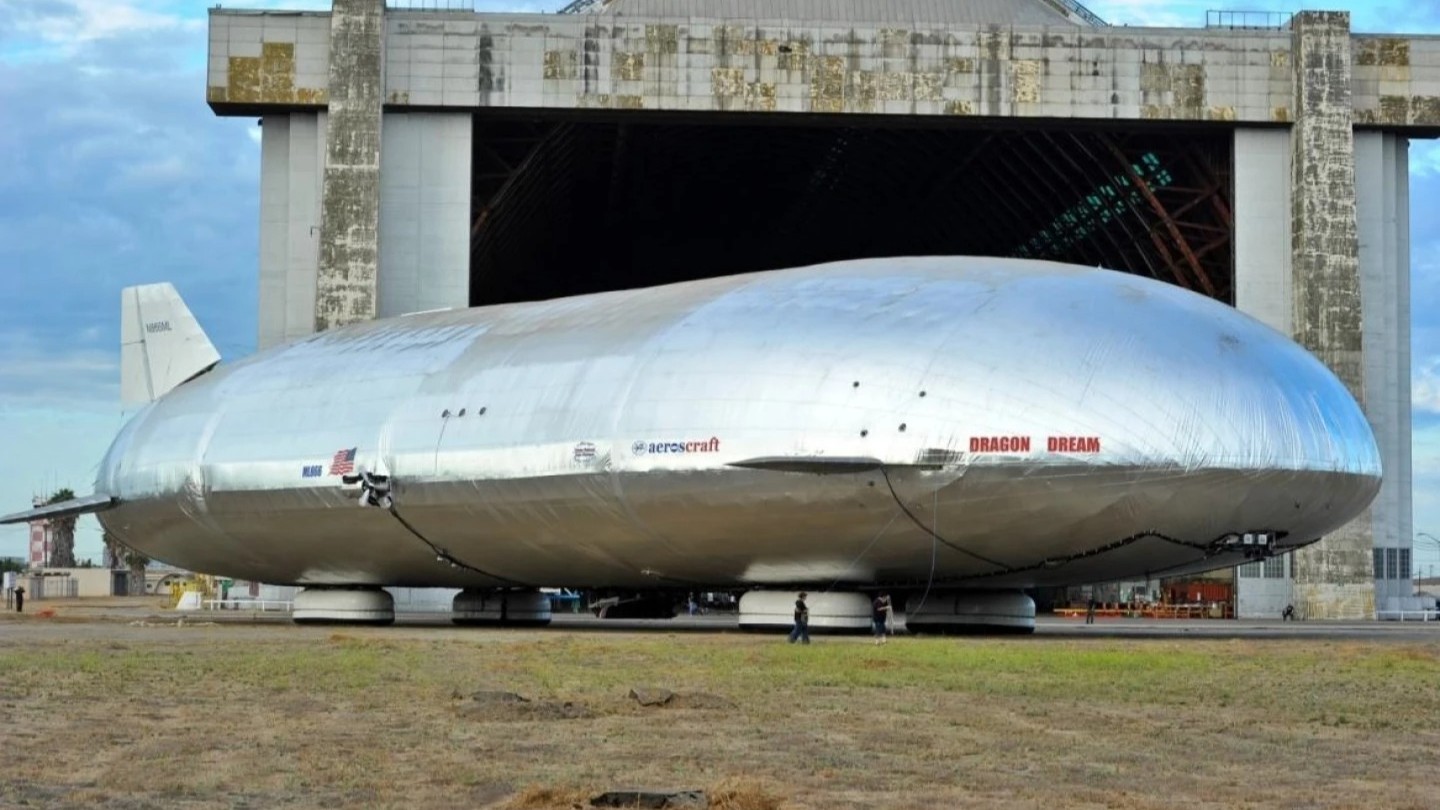
This new airship was called the Pelican, and the Pentagon believed in it so much that it funded the project to the tune of $50 million.
In 2013, Aeros had done it again. The Pelican, now called the ‘Dragon Dream’ took its first flight. This airship, which was a prototype for the Aeroscraft, measured 266 feet long and 97 feet wide. Power came from a triplet of Lycoming AEIO-540 SER 8.9-liter flat-six engines, which made 260 HP each. The envelope had a volume of 600,000 cubic feet, and the airship had a gross weight of 36,000 pounds.
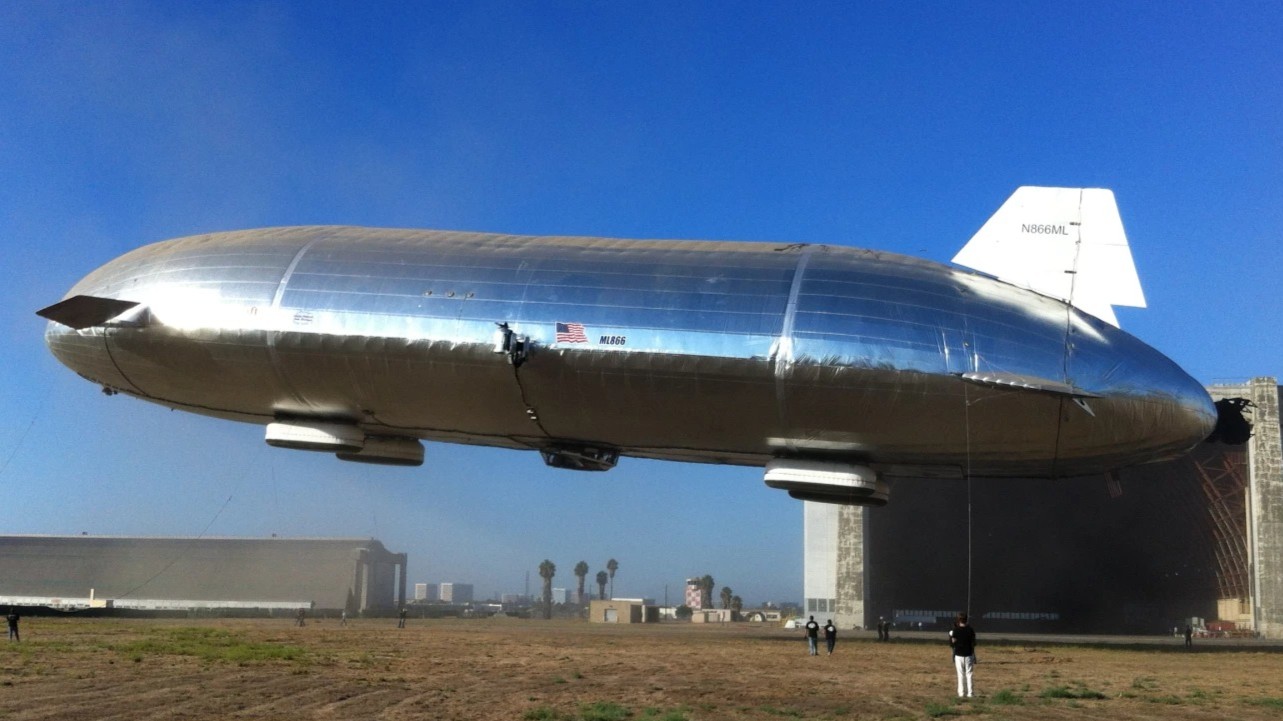
Sadly, the Dragon Dream was deregistered in 2014, and then the airship was badly damaged in a hangar collapse in 2015. But that hasn’t stopped Aeros from dreaming big.
Aeros says that the Dragon Dream was a half-scale functional demonstrator of its planned production Aeroscraft, which is honestly pretty absurd. The Dragon Dream was already 16 feet longer than a Boeing 747-800, but the production version, the Aeroscraft Model ML866, is supposed to measure 555 feet long, or 305 feet longer than the aforementioned 747-800.

This beast, Aeros says, will be able to carry a payload of 66 metric tons, cruise at 120 mph, cover a distance of 3,100 miles on a single fueling, and hold 8,800 square feet of cargo. That’s roughly twice as much cargo as the largest Boeing 747 freighters.
That’s insane enough, but Aeros wants to make an even bigger version called the Aeroscraft Model ML888, which would measure 770 feet long, carry a payload of 244 metric tons, fly 6,200 miles, and hold a ridiculous 23,180 cubic feet of cargo in its hold. The Aeroscraft is expected to fly up to 10,000 feet.
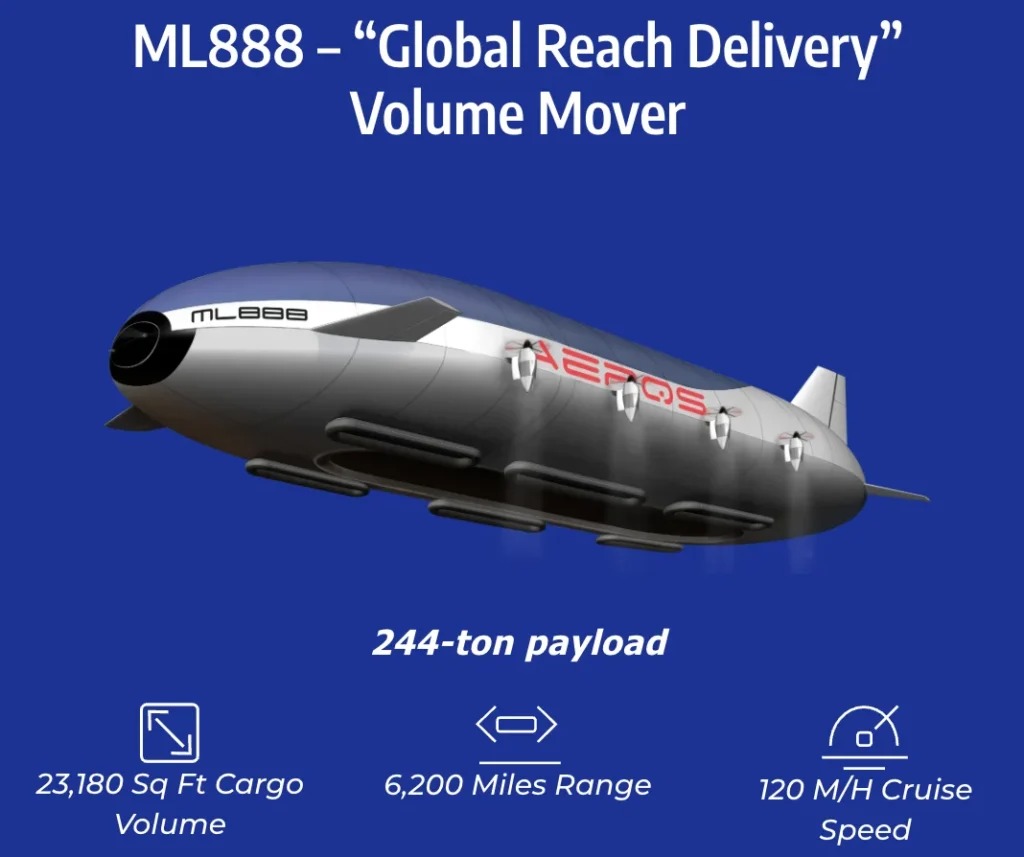
As crazy as all of this sounds, it’s actually not that far off from what has been done before. Hindenburg-class airships were 803 feet long and carried 242,200 pounds of people and cargo. What would be interesting to see is the claimed 537,927-pound payload of the ML888.
This time, Aeros isn’t pitching its Aeroscraft as a military craft, but the ultimate solution for logistics. In Aeros’ eyes, the Aeroscraft can carry a crazy amount of humanitarian aid after a natural disaster, be used to airlift the world’s largest wind turbine blades to wind farms, and provide a solution to any logistics operation that is apparently hamstrung by relying on trucks, trains, ships, and fixed-wing aircraft.
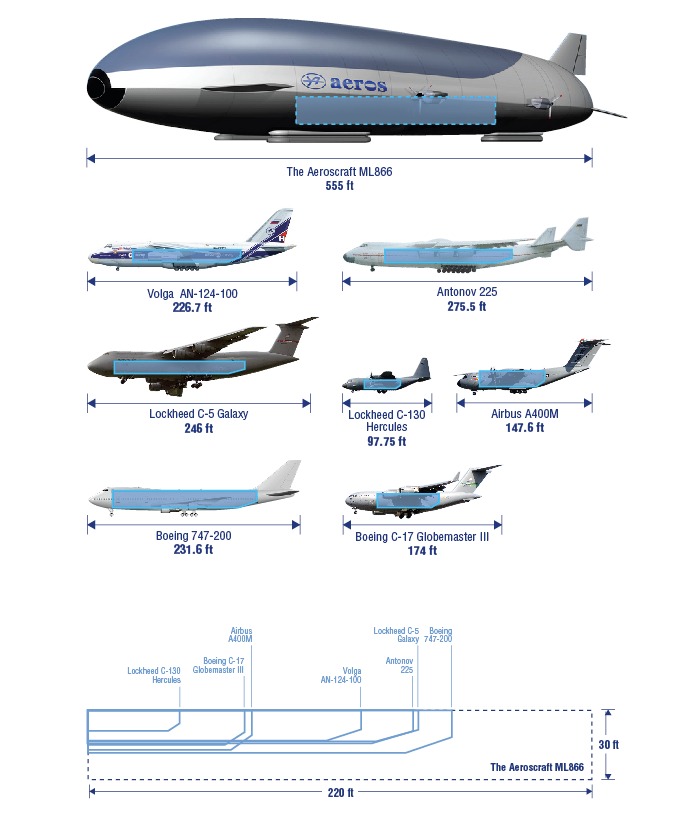
In other words, Aeros sees the Aeroscraft fulfilling a similar role that Radia wants to use for its WindRunner aircraft, but this one is supposed to be a ridiculously huge airship rather than a comically long fixed-wing plane.
The Flying Amazon Fulfillment Center
If this isn’t weird enough for you yet, it gets weirder. Not content with trying to reinvent shipping, Aeros wants to disrupt warehousing, too. Aeros has partnered up with a producer of cargo drones. Why? Aeroscraft wants to create what it calls an Airborne Warehouse and Airborne Fulfillment Center.
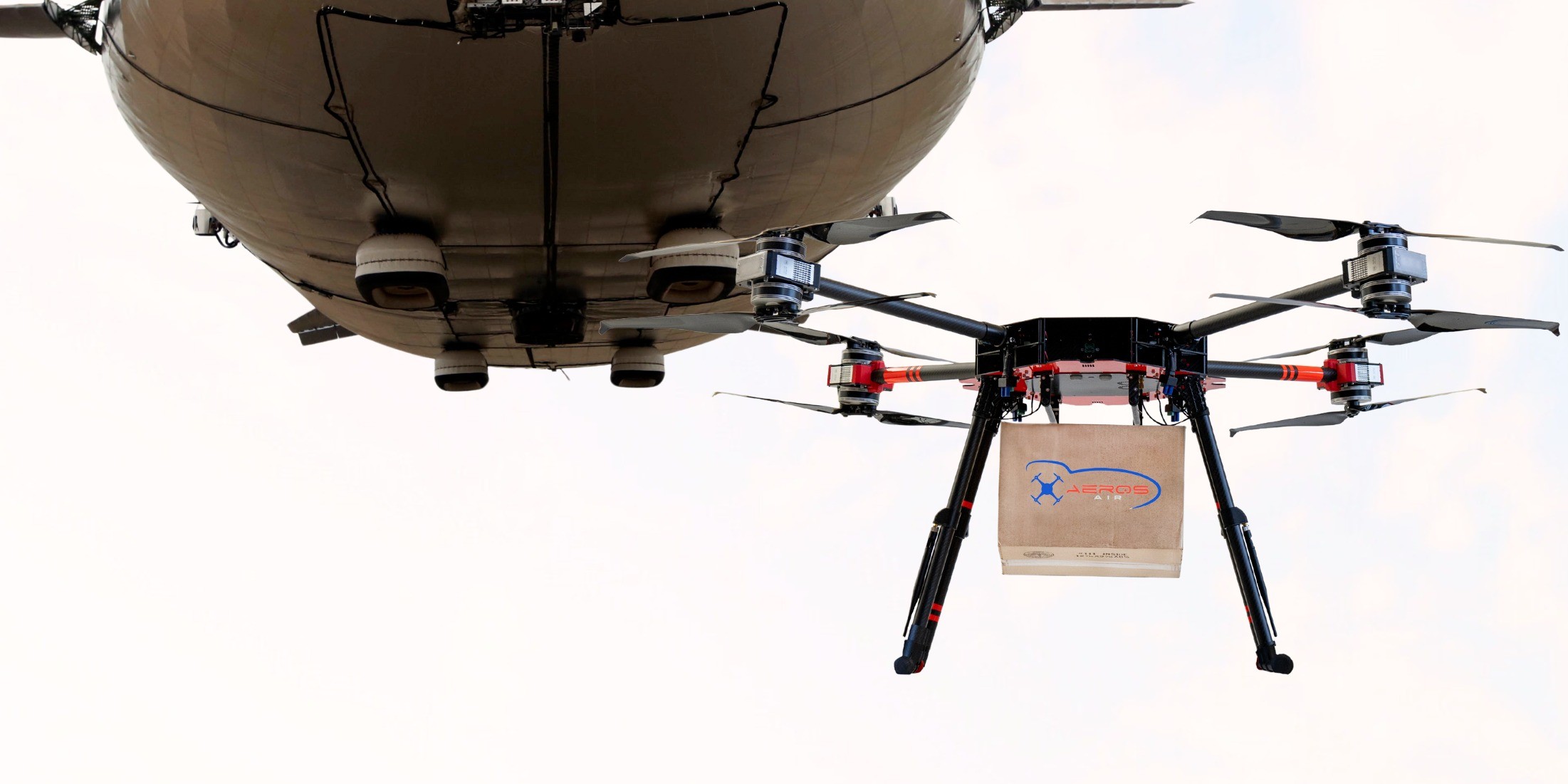
I’ll just hand Aeros the mic here:
60-MINUTE DELIVERY
Our airships navigate directly from the warehouse to the delivery area, with drones delivering packages straight to the customer’s front door, bypassing traffic congestion and difficult terrain. This provides unmatched speed and efficiency that no one else can match.66% REDUCTION IN YOUR SHIPPING COSTS
Your customers will enjoy lower prices compared to your competitors, thanks to our unprecedented operational efficiency. The ML806 airship and drone system can deliver 4,000 consolidated packages per hour, significantly reducing shipping costs.YOUR COMMITMENT TO SUSTAINABILITY
Your customers will be pleased to know that our airships and cargo drones are electric and produce zero emissions. One ML806 system removes 110 delivery vans from the road, reducing 4,535,000 lbs of CO2 emissions annually.

Aeros wants this to work exactly how you’re picturing it. An Aeroscraft airship will float above Los Angeles, and thousands of drones would be flying into and out of its hold. In essence, this airship will basically be a flying Amazon-style warehouse.
Aeros hopes to launch a pilot program this year. The demonstrator will be an Aeros Sky Dragon surveillance airship, which will have a 1,980-pound payload. Drones will then fly into and out of the Sky Dragon, delivering packages around a small part of Los Angeles.
The idea here is really just to prove that a floating warehouse is a viable concept. Then, Aeros plans on launching what it calls the Aeroscraft ML806, a 262-foot-long airship with a 10 metric ton payload. This airship will have a crew of five — two pilots, a drone pilot, a supervisor, and a loadmaster — and Aeros expects to have three of them in production by 2027.
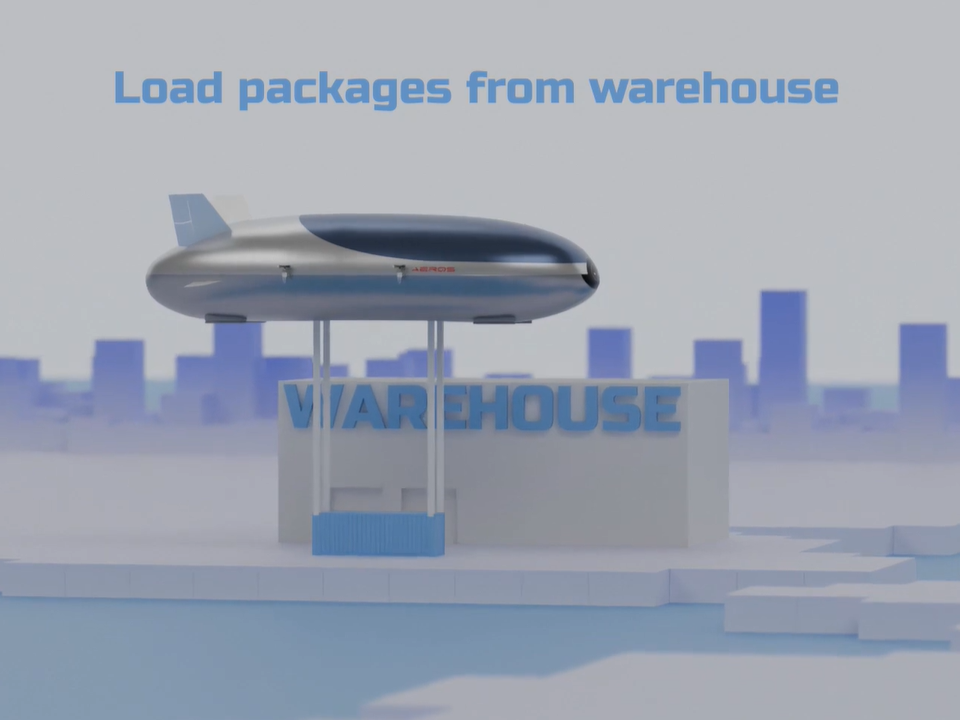
One of the problems that Aeros may face is the fact that, while the Aeroscraft is expected to hover at 1,200 feet above ground level, drones aren’t allowed to fly higher than 400 feet. According to a recent report by FlightGlobal, Pasternak is in talks with the FAA, and the FAA apparently supports this flying warehouse deal.
There are some big questions that remain. Will Aeroscraft be able to make an airship as large as it says it can? Is there a market for a long-range aircraft that can fly at only 120 mph? Do people want a warehouse flying over their heads with lots of drones buzzing in and out of it?
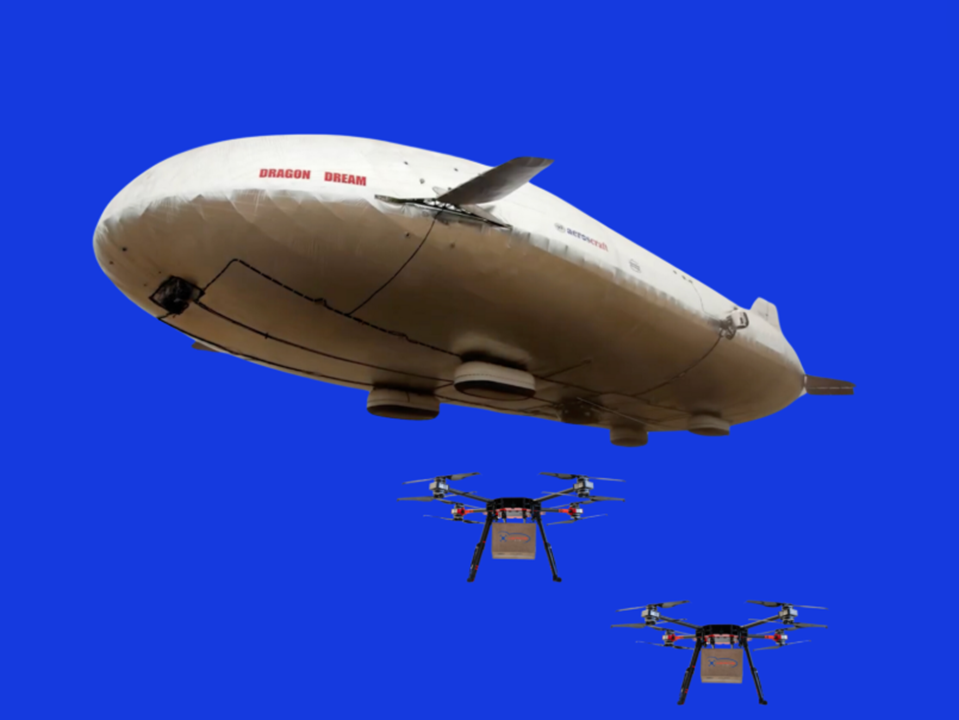
That speed factor alone has me scratching my head. Aeros is pitching its Aeroscraft airships as being able to deliver aid and other time-sensitive cargo. Sure, these aircraft won’t need infrastructure like an airport and can land and take off vertically, which means that they can deliver cargo directly to the ground after a disaster. However, given the airship’s slow cruising speed, it might still be faster to use a jet, anyway.
But these questions are still pretty far out. Aeros needs a lot of money to make this happen. The company plans to raise an undisclosed amount of money through a Regulation A public offering, which has a limit of $75 million. According to a press release published last month, Aeros has also signed a “Memorandum of Understanding with a major global institutional investor.” The details of this, including the identity of the investor, are not available. Aeros also says that it has “signed a multi-million-dollar agreement to initiate commercial parcel delivery using our AFC platform,” but again, no further details have been made public. For now, Aeros has a link on its website to reserve shares in the company.
It’s hard to say if Aeros will be able to pull this off. To his credit, Igor Pasternak has been working on this technology for the better part of 30 years, and I admire his commitment to his dream. Even if he just builds the small 10-ton airship, that would be pretty awesome to witness. Either way, it’s so cool to see airships trying to find some way to work in the modern day.








Is it just me, or is this a spittin’ image of Thunderbird 2 (“Thunderbirds are GO!!”): https://www.youtube.com/watch?v=fEDcZBGZtrs
The warehouse thing sounds like a fucking nightmare. Nobody wants this bloated monstrosity floating above their town. It would make me want to shoot all the stupid drones. Also, nobody needs a bunch of shit from Amazon. Key word: minimalization
I agree 100%. If something goes wrong this will be a complete nightmare and in this day and age it will
I’m not buying the floating warehouse with swarms of drones thing, but I am buying the potential of these for trans-oceanic shipping!
Just FIY the meaning of his last name:
https://www.hellozdrowie.pl/wp-content/uploads/2021/03/istock-538323254.jpg
Do a comparison illustration with the Super Guppy!
Folks been working on this shit for decades. Here’s an example from 45 years ago of how these things mostly end up.
Like all red-blooded nerds, I’m an airship proponent, but if they hover one of those things over my city and start dropping quadcopters out of it, we’re gonna find out just how flammable those helium tanks are.
What??? Helium is inert and can’t burn. And are you saying someone (maybe not you) will start trying to shoot them down?
> Helium is inert and can’t burn
Yes, that’s the joke
There are many reactions to this concept, and one of them is that some drunken idiot with a high-powered rifle will try to take it down as it goes by. It’s a very large target.
On a less cynical note, kudos to those who think and design beyond the current status quo.
One does wonder what winds at altitude might want to do with this huge balloon, though. Its performance would be much better on calm days.
“Aeros needs a lot of money to make this happen.” Aeros should partner with Aptera and launch a joint GoFundMe platform.
Blade runner off world flying billboard?
That map looks like the delivery service area will be smack dab in the crosshairs of the Santa Ana winds. 100 MPH gusts of hot dry air that caused 2 infernos that burned down over 18,000 buildings just this year. This blimp will be blown off course and into the ocean in minutes.
It would not be flying in such conditions, along most other aircraft.
With a thing of that size you really don’t have a choice where you fly it sometimes
This sounds like a great idea. Will I be able to land my flying car on one, and if so, can I have my Tesla robot walk inside and get my package?
At 800′ long you can probably land your Cessna on one.
This really isn’t that crazy of an idea. Slap solar cells all over it and it seem even less nutty to me. The buoyancy control system removes a lot of cons from the dirigiable equation. Easy peasy or problem free? Absolutely not, but viable? Maybe.
One loadmaster and his supervisor are going to offload 4000 packages an hour onto drones? I don’t think so.
It isn’t clear what jobs any of the last three guys are going to perform. How many drones is the one drone pilot going to fly?
Tanks of compressed helium don’t float away while the clown making balloon animals at kids’ parties fasions yet another horsey, right? And helium is a finite resource, right? Instead of venting the gas to reduce buoyancy during flight to land, does anyone re-compress some of the helium in the airship envelope back into tanks instead, so that it can be used again later? Or is it not practical to do that due to weight or something?
The way most airships adjust buoyancy in flight is to pump outside air into special chambers called ballonets that then make the airship heavier or pump the air out of the ballonets to make the airship lighter.
Helium isn’t vented.
The idea on this airship is to compress the helium since it needs to adjust buoyancy more than can be accomplished with ballonets.
Thanks for the clarification… for some reason I thought that helium was vented to the outside after reading this article.
This sentence certainly seemed to imply it:
“Operators can add ballast or release lifting gases to reduce buoyancy, and drop ballast to increase buoyancy.”
That’s what made me think about re-compressing some of the helium to save/reuse it, since it seemed wasteful to just vent it away.
It seems they had the same thought, later on in the article.
And helium is a very finite resource. Just Google “helium shortage” and start worrying about whether you’ll be able to get an MRI.
It seems stupid to waste it in party balloons. But it is also still funny to inhale it and talk.